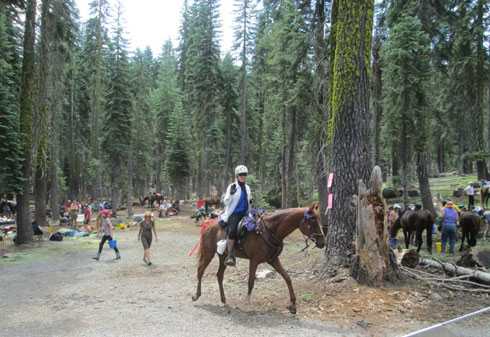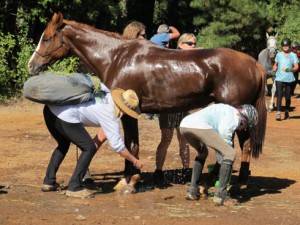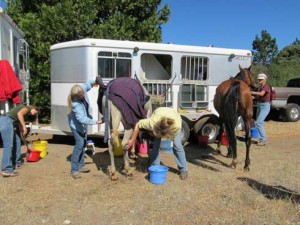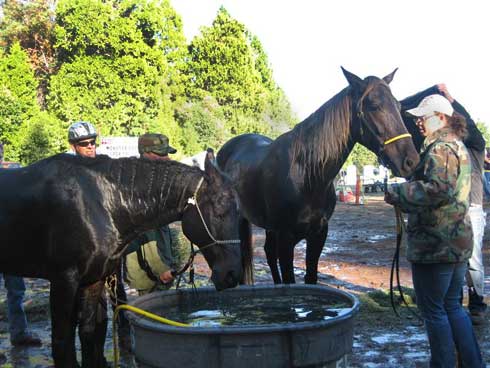Tevis 2012: Grounds for Research
By Marsha Hayes August 4, 2012
A horse and rider leave Robinson Flat vet check area at the 2012 Tevis Cup Ride. (Photo by Elizabeth Funderburk)
The 100-mile Tevis Cup endurance ride got underway at Lake Tahoe in the wee hours of morning, marking the 57th running of the event. The extremity of the terrain – sheer descents, vertical climbs and rivers to be forged – lend it mythic status, its place in history guaranteed by the fact that it is unique on the world stage: a trail ride that is at once a high-performance contest in which a small percentage of starters compete. The catch phrase is, “To finish is to win,” and it’s true.
After nearly six decades, the Tevis continues to surprise. Last year it took place in a snowstorm. This year, some lesser-known firsts are that the 2012 Tevis Cup Ride is dedicated to Forrest Hills, CA, resident Walt Tibbitts, described as a “horseman and explorer” whose “steady guidance has helped the Western States Trails Foundation [producer of the event] meet every challenge along a winding trail that spans 45 years.”
Another little known fact is that this year’s TCR will host three different equine medical trial studies.
Among the incentives to turn Tevis into a field research lab was the high level of rider participation; there were 217 starters listed as of Aug. 3 (a modern high water mark).
Veterinarians will use the event to expand their knowledge of equine athletes performing at their highest levels. Most U.S. 100-mile events field only 12-15 entries, and are held in conjunction with shorter, 50- to and 25-mile trails. “The reason Tevis is so useful is the numbers,” head Tevis veterinarian Dr. Greg Fellers explained.
The new 2012 study, titled “Creation of a Metabolic Score Based on Basic Laboratory Parameters” will be led by Dr. Langdon Fielding, DVM, of the Loomis Basin Equine Medical Center, Placer County, CA. Assisting him is Dr. Gary Magdesian, DVM, University of California, Davis.
This year all horses reaching the 36-mile mark at Robinson Flats will have a very small ( 1-3 ml) blood sample drawn after they have “reached criteria” – a heart rate of 60-beats-per-minute that signals the start of the horse’s mandatory (under Tevis rules) one-hour rest phase.
The official event veterinarian Dr. Greg Fellers, said he was looking forward to a choreographed effort between on-site treatment vets and testing personnel to optimize the data. The mobile lab units are equipped to turn around blood work in as little as 15 minutes.
The Western States Trail Foundation is funding the cost of research and sponsors have donated equipment and materials, according to Fellers. The trial will continue in 2013 to add more numbers to the research data. Researchers will look closely at the lab work of horses that are “pulled” during the course of the ride and will seek to identify markers that could possibly signal that a horse is headed for trouble. “Marked dehydration and electrolyte imbalances are two things we are looking for,” Fellers said. “This research could possibly provide more information about changes that occur metabolically that are not apparent in the physical examination.”
The goal of the project is to prevent illness and injury while improving completions. Dr. Fielding hopes the research can be used to create an endurance metabolic score (EMS). Using his envisioned 1-10 EMS score, future endurance events might provide onsite laboratory results and a powerful tool for both riders and veterinarians to objectively evaluate horses.
Also attracted by the large field of elite 100 mile athletes, Dr. Olin Balch, DVM, MS, PhD, chairman of the American Endurance Conference ( AERC) Research Committee, Cascade, ID, will be on location at Tevis, encouraging riders to participate in a 13-page research questionnaire. In 2009 the AERC Research Summit found little follow-up on the issue of pulls and horses requiring medical treatment at Tevis. The survey seeks input from both successful and unsuccessful participants in 100 mile events. Detailed questions about rider and equine history, veterinary history, hoof care, training schedule, diet, electrolyte supplementation, and travel to rides are put forth. The survey also covers tack, weather, and other information relevant to the experience.
(Although the idea is to get the survey filled out on-site, The Equestrian News is investigating whether an online version might be made available subsequent to the event.)
The third research study to be performed in conjunction with Tevis 2012 will be conducted by Dr. Karen Hasan, DVM, of Roseville, CA. A board certified surgeon with an interest in trail performance and lameness. Hasan is involved in a study that involves diagnostic nerve blocks on horses pulled due to lameness to search for causes and effective treatments. She has gathered data from the Gold Country and American River Ride 50 mile events. Her extensive (and free!) examinations may involve lengthy observations and trot-outs as she explores the various aspects of her areas of interest. Hasan continues her research, following each horse at specific intervals for weeks and months prior and following the events.
Short URL: https://theequestriannews.com/?p=11986





